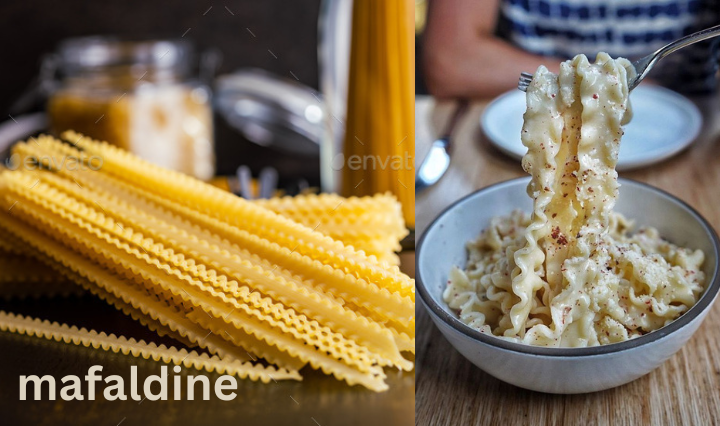Outline of the Article
- Introduction to Mafaldine
- Origin and History
- Ingredients and Preparation
- Types of Flour Used
- Traditional vs. Modern Methods
- Popular Variations and Recipes
- Classic with Tomato Sauce
- With Pesto Genovese
- Seafood
- Cultural Significance
- Health Benefits
- Availability and Where to Buy
- Cooking Tips and Techniques
- Pairing with Sauces and Ingredients
- In Popular Culture
- Conclusion
Introduction to Mafaldine
Mafaldine. Also known as little queens. Are a type of pasta characterized by their long. Flat ribbons with rippled edges. This pasta shape is beloved for its ability to hold sauces and ingredients. Making it a versatile choice for various dishes.
Origin and History Mafaldine
Mafaldine pasta traces its origins to Italy. Particularly to the region of Naples. Legend has it that the pasta was named after Princess Mafalda of Savoy in the early 20th century. The shape was created to mimic the princess’s hairstyle. With long, wavy strands.
Ingredients and Preparation
Types of Flour Used Mafaldine
Mafaldine is typically made using semolina flour. Which gives it a sturdy texture and allows it to hold up well to different sauces.
Traditional vs. Modern Methods Mafaldine
While traditional methods involve hand rolling and cutting the pasta dough. Modern production often involves mechanized processes. However. Artisanal producers still adhere to traditional techniques. Resulting in a superior quality product.
Popular Variations and Recipes
Mafaldine can be prepared in various ways to suit different tastes and preferences. Some popular recipes include:
- Classic with Tomato Sauce: A simple yet delicious dish featuring homemade tomato sauce and fresh basil.
- With Pesto Genovese: This recipe combines the rich flavors of basil pesto with the delicate texture of.
- Seafood: A decadent seafood pasta dish featuring mussels. Shrimp. And a white wine sauce.
Cultural Significance Mafaldine
Mafaldine holds cultural significance in Italy. Where it is often enjoyed during festive occasions and family gatherings. Its association with Princess Mafalda adds a touch of royalty to the dining experience.
Health Benefits
Mafaldine. Like other pasta varieties is a good source of carbohydrates. Providing energy for the body. When paired with nutritious ingredients such as vegetables and lean proteins. It can be part of a balanced diet.
Availability and Where to Buy
Mafaldine pasta is widely available in Italian specialty stores and gourmet food shops. It can also be purchased online from artisanal producers who specialize in traditional pasta making techniques.
Cooking Tips and Techniques
To cook pasta perfectly. It’s essential to use a large pot of boiling. Salted water and to follow the package instructions for cooking times. Be sure not to overcook the pasta. As it can become mushy.
Pairing Mafaldine with Sauces and Ingredients
Pairs well with a variety of sauces and ingredients. Including creamy Alfredo sauce. Hearty meat ragu. And fresh vegetables. Experiment with different flavor combinations to discover your favorite.
Mafaldine in Popular Culture
Mafaldine pasta has made appearances in popular culture. Including in films. Television shows. And literature. Its elegant appearance and delicious taste have made it a favorite among chefs and food enthusiasts worldwide.
Conclusion
In conclusion. Mafaldine pasta is a versatile and delicious option for pasta lovers everywhere. Whether enjoyed with a classic tomato sauce or dressed up with gourmet ingredients. Is sure to delight the taste buds and add a touch of elegance to any meal.
FAQs
- Is mafaldine pasta gluten-free?
- No. Pasta is typically made from semolina flour. Which contains gluten.
- Can I freeze cooked pasta?
- While it’s possible to freeze cooked pasta. The texture may change slightly upon reheating.
- How long does it take to cook pasta?
- Cooking times can vary depending on the brand and thickness of the pasta. But it typically takes around 8 10 minutes.
- What sauces pair well with pasta?
- Pasta pairs well with a variety of sauces. Including tomato. Pesto. Alfredo. And seafood based sauces.
- Where can I find pasta?
- Pasta can be found in Italian specialty stores. Gourmet food shops. And online retailers that specialize in artisanal pasta products.
